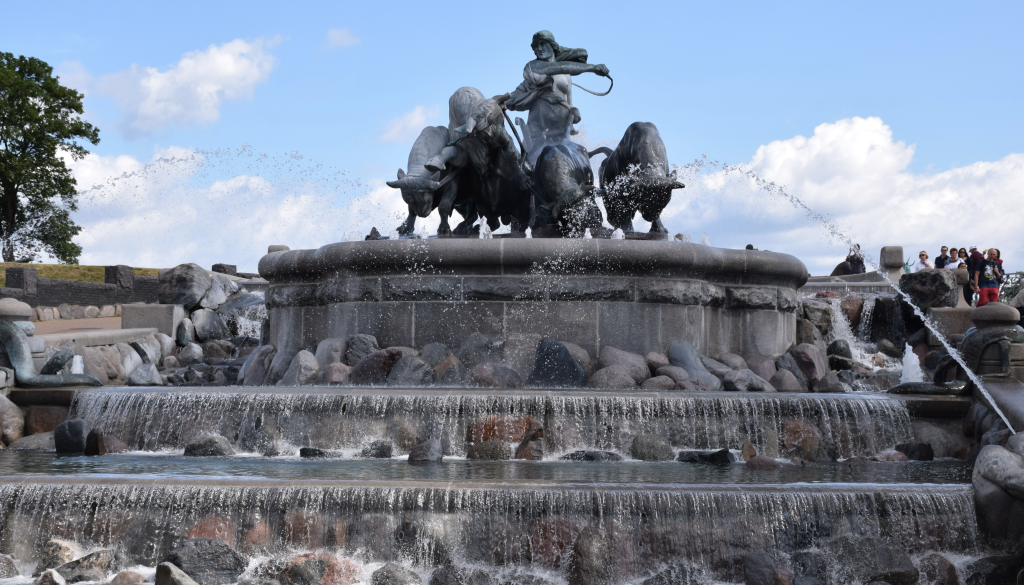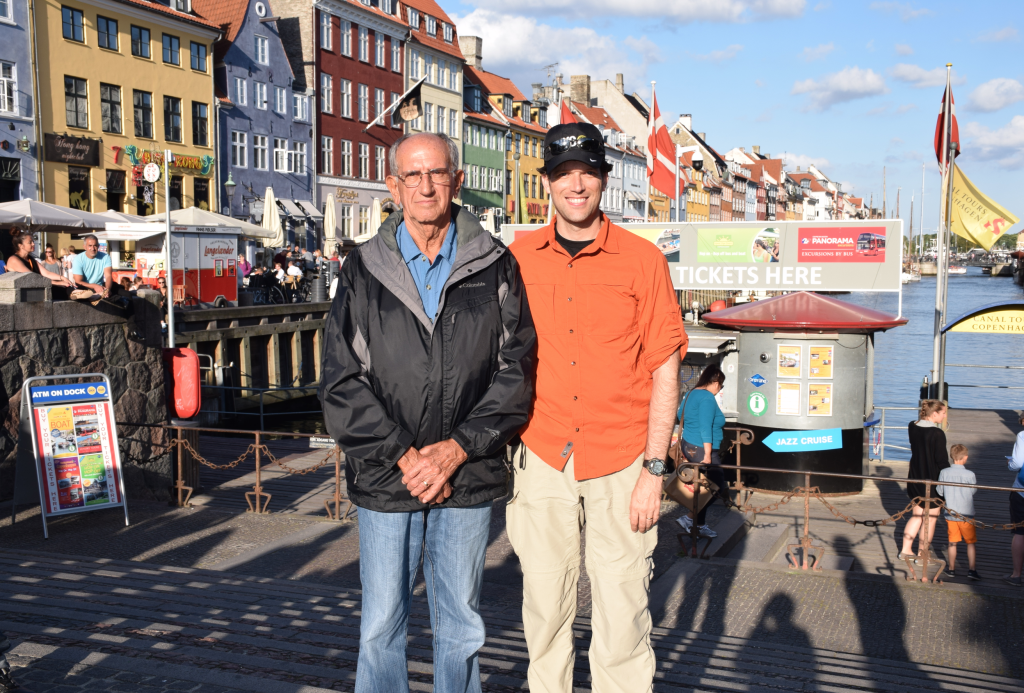After a nice breakfast at the Hotel, we boarded a motor coach at 9am and headed into the city of Copenhagen. Our tour guide for the day was named Anna, and she was awesome. We learned that the population of Copenhagen is around 575,000 and that the overall population of Denmark is over 5 million. There is very little bandwidth for traffic in Copenhagen, so the primary method of transportation is bicycle. It was very difficult for our bus to navigate the 2-lane roads of the city with all of the congestion.

Our first stop was at Christensborg Castle. This castle has burned down twice and the current structure was built in the 17th century. We did not go inside the castle, but walked around the grounds and saw the entrance to the Denmark parliament, which is located within the castle. I found it interesting that they have no idea who the figures are who are carved above the entrance, so the people of Copenhagen call them headache, earache, toothache, etc. because of their poses and the position of their hands. In the back of the castle was a statue to Christian IX, who is known as the father-in-law of Europe because of how many children he had, and how many of his daughters ended up as royalty in other countries.
While walking around we saw the Royal Library and garden, which was originally part of the Copenhagen harbor. We also saw the Ministry of Finance (built in 1720), and the stock exchange building (built by Christian IV). Our guide said that most of the buildings in Copenhagen are not old because of major fires in the city.

After another short ride on the motor coach we parked by the harbor and walked to Churchill Park (Churchillparken) to see the Gefion Fountain (Gefionspringvandet), which is the largest fountain in Scandanavia. It depicts Lady Gefion who travelled to Sweden and mythically turned her 4 sons into bulls so they could do more work. While at the fountain, we also briefly toured St. Albans Anglican Church, which is the only Anglican Church in Denmark. It was constructed in 1887, and was a beautiful building. From the harbor we were also able the see their modern Opera house, which cost 2.5 billion DRK (367 Million U.S.).

Our next stop was at the statue of the Little Mermaid which commerates the fairy tale by Hans Christian Andersen. The statue was constructed in 1913, and is directly on the edge of the harbor. It was hard to photograph for 2 reasons: (1) the sun was directly behind the statue, and (2) it was running over with tourists. The original story was quite a bit more violent than the Disney interpretation, but I guess that is true of most of the fairy tales Disney has adapted into movies.
Next we drove approximately 40km along the sound between Denmark and Sweeden. It was neat to see Sweeden in the distance and I also enjoyed seeing the Danish countryside by the sea. There were LOTS of sailboats. We arrived in Helsingør and had an interesting lunch at the Marienlyst hotel near Kronborg Castle. I ate duck (cold), sliced turkey, cold green beans, and some type of mystery starch. Not bad, but a little different than what I’m used to.

After lunch we parked near Kronborg Castle and made the short walk to the entrance. The original castle was called Krogen, and was built by Eric VII in the 1420. This castle was expanded and turned into a renaissance castle by Frederick II in 1585. It subsequently burned down in 1629, and was rebuilt by his son Christian IV in 1637. The chapel within the castle is from 1585, and it is stunning.
This castle is the setting for Shakespeare’s Hamlet, though there is a lot of disagreement as to whether or not Shakespeare ever came to the castle. Regardless, Hamlet was performed many times at Kronberg between 1585 and 1629. The last King to use the castle was in the 1700s, and it was a military barracks from 1785 to 1924. It opened to the public in 1935.
Touring this castle was phenomenal. One side of it is on the sea, and the other sides are surrounded by a moat. It was beautiful on the outside and incredibly interesting on the inside. From the inner courtyard we toured the chapel, the casemates (dungeon and storehouse under the castle), and I broke off from the group and walked upstairs to see the king’s and queen’s quarters and the queen’s gallery. The casemates were very cool (literally and figuratively), but a little creepy. This structure actually dates from the original castle in 1420.

After leaving the castle, we travelled back to Copenhagen and arrived at our hotel around 4:30pm. After a short rest, Patsy, Ben, Daddy, and I took the Metro back to downtown Copenhagen. We stopped at a place that looked like a local restaurant, but it turned out to only be a bar. One of the servers recommended a restaurant down the adjacent alley called Skindbuksen. Turns out it was started in 1728, and is the oldest restaurant in Copenhagen (the restaurant is older than America!). Our waiter, Martin, said that they only serve traditional Danish dishes. Patsy and I shared a pork loin, potatoes, and red cabbage platter, and it was delicious. I especially enjoyed the red cabbage.

From there we walked over to the “New Harbor” area and enjoyed a little bit of a local jazz festival, before stopping for some ice cream at a place called rajissimo. There was a guy inside the little shop making waffle cones using a little machine that had 4 waffle irons on a spindle. The ice cream and waffle cone were really good.
We are now back at our hotel, and soon it will be time for bed. I got to talk to Olivia, Kate, and Sara, which was great. I miss them like crazy, and it’s only been 3 days!!
Our luggage is still not here, but it is supposed to arrive at the hotel by Midnight. Hopefully this will be the case, or it is going to be a very stinky cruise for many of us! We leave for the dock around 11am tomorrow and then set sail for Oslo, Norway around 5pm.
